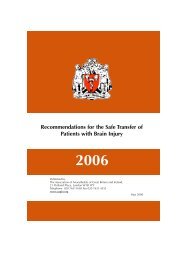TheatrePracticeStandardsGeneric1
You also want an ePaper? Increase the reach of your titles
YUMPU automatically turns print PDFs into web optimized ePapers that Google loves.
• The labelled container must be shown to the scrub practitioner in conjunction with the<br />
details as they are recorded in the patient’s notes. This may be achieved by showing<br />
the scrub practitioner the notes, consent form or operating list. The documentation<br />
used must previously have been checked for accuracy of the details.<br />
• The information on the investigation request form must correspond with the details on<br />
the specimen container and the patient’s notes. It must also contain relevant clinical<br />
information to assist the laboratory staff.<br />
• It is vital that all information is checked and accurate before the specimen leaves the<br />
operating theatre. The specimen must be accompanied by the documentation.<br />
• The security and labelling of any operative specimen is the responsibility of the<br />
scrub practitioner responsible for the case.<br />
• In the event of urgent specimens the laboratory staff must be notified (Royal College of<br />
Pathologists 2005).<br />
• A log must be kept to track the specimen from the theatre to the laboratory or<br />
pathology department. A signed record must be kept of all specimens dispatched from<br />
the perioperative setting. Names must be printed as well as signed.<br />
• Handling Specimens<br />
• Care must be taken when selecting an appropriate specimen container, in relation to its<br />
size and purpose. For histopathology specimens, the container must be large enough<br />
to ensure that the specimen floats freely, is completely covered by appropriate fixative<br />
and is sealed for transportation.<br />
• The circulating practitioner must follow standard precautions when placing the<br />
specimen in the container. Precautions must be taken to prevent any contamination of<br />
the outside of the specimen container.<br />
• All staff must adhere to COSHH regulations and Trust policies for treatment of splash<br />
injuries from specimen fixative or body fluids.<br />
• All specimens for microbiology must be placed in a specified biohazard bag which is<br />
sealed before dispatch.<br />
• All staff must adhere to Trust standard precautions when handling specimens in<br />
accordance with local policy.<br />
• If specimens cannot be taken to the laboratory within the specified time limits (e.g. at<br />
night) they must be stored in accordance with the RCHT Pathology Specimen<br />
Handbook instructions (Royal College of Pathologists 2005). Some specimens without<br />
fixatives may need to be stored in a dedicated specimen fridge at a temperature of 4°C,<br />
thus minimising the potential for bacterial growth. However, storage at 4°C is<br />
inappropriate for specimens in formalin, as this will delay fixation of the specimen.<br />
Blood cultures collected must be transferred immediately to microbiology.<br />
• The specimen must be removed from the operating theatre before the next scheduled<br />
patient arrives.<br />
• Specimens for frozen section are placed in dry containers, labelled as stated and must<br />
be dispatched immediately to the appropriate department (Royal College of<br />
Pathologists 2005).<br />
• Results of frozen sections must be received and a written record made by a member of<br />
medical staff.<br />
• Foreign Bodies<br />
• Foreign bodies must be clearly labelled and retained for inspection.<br />
64





